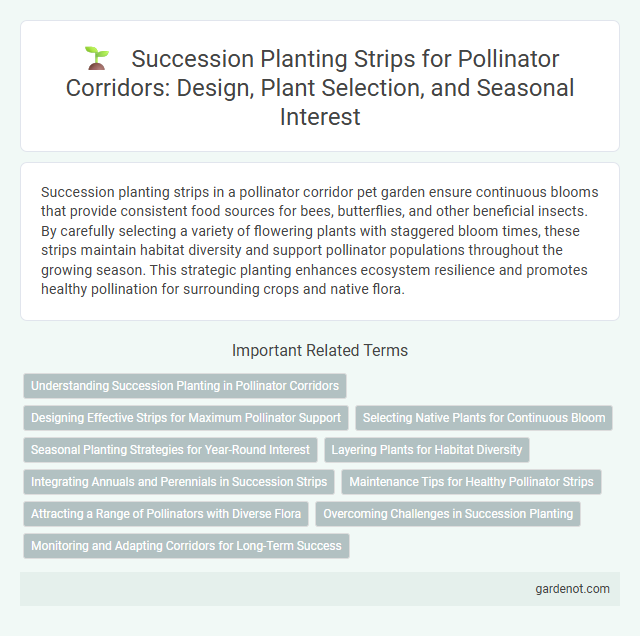Succession planting strips in a pollinator corridor pet garden ensure continuous blooms that provide consistent food sources for bees, butterflies, and other beneficial insects. By carefully selecting a variety of flowering plants with staggered bloom times, these strips maintain habitat diversity and support pollinator populations throughout the growing season. This strategic planting enhances ecosystem resilience and promotes healthy pollination for surrounding crops and native flora.
Understanding Succession Planting in Pollinator Corridors
Succession planting in pollinator corridors involves strategically timing the planting of various flowering species to ensure continuous bloom throughout the growing season, which supports diverse pollinator populations by providing consistent food sources. This method enhances habitat connectivity and floral diversity, crucial for sustaining bees, butterflies, and other pollinators essential for ecosystem health. Implementing well-planned succession strips optimizes resources and maximizes pollinator visitation rates, promoting biodiversity and resilience in agricultural and natural landscapes.
Designing Effective Strips for Maximum Pollinator Support
Designing effective succession planting strips requires selecting a diverse range of native flowering plants with overlapping bloom periods to ensure continuous nectar and pollen sources throughout the growing season. Incorporating varying plant heights and flower structures enhances habitat complexity, attracting a wide array of pollinator species such as bees, butterflies, and hummingbirds. Strategic placement along pollinator corridors maximizes connectivity between fragmented habitats, promoting pollinator movement and biodiversity conservation.
Selecting Native Plants for Continuous Bloom
Selecting native plants for a succession planting strip ensures continuous bloom by incorporating species with staggered flowering periods, supporting pollinators throughout the growing season. Native perennials such as Echinacea, Solidago, and Monarda provide essential nectar and pollen resources from spring through fall, promoting biodiversity and ecosystem resilience. Designing a diverse pollinator corridor with locally adapted flora enhances habitat connectivity and sustains native pollinator populations year-round.
Seasonal Planting Strategies for Year-Round Interest
Succession planting strips enhance pollinator corridors by providing continuous floral resources throughout the growing season, supporting diverse pollinator species. Early spring bloomers like crocus and wild violets transition into summer favorites such as coneflowers and milkweed, followed by late-season asters and goldenrod to sustain pollinators into fall. This strategic layering of plants ensures year-round nectar and pollen availability, promoting ecological resilience and biodiversity within the corridor.
Layering Plants for Habitat Diversity
Succession planting strips with layered plants create diverse habitats essential for pollinators by providing continuous blooms and varied structural complexity. Incorporating ground covers, mid-height perennials, and tall flowering shrubs supports different pollinator species throughout their life cycles and seasonal needs. This stratified approach enhances nectar and pollen availability, promoting sustained pollinator activity and biodiversity in corridor ecosystems.
Integrating Annuals and Perennials in Succession Strips
Integrating annuals and perennials in succession planting strips enhances pollinator corridors by providing continuous floral resources throughout the growing season. This strategic combination supports diverse pollinator species by ensuring staggered bloom times, which maximize nectar and pollen availability. Succession strips combining fast-growing annuals with longer-lasting perennials create resilient habitats that improve biodiversity and ecosystem services in agricultural landscapes.
Maintenance Tips for Healthy Pollinator Strips
Succession planting strips require regular monitoring to ensure continuous bloom and habitat for pollinators throughout the growing season. Trim spent flowers to encourage new growth and prevent disease, while watering deeply but infrequently to promote drought resilience. Removing invasive weeds promptly reduces competition and supports the diversity of native pollinator-attracting plants essential for a thriving corridor.
Attracting a Range of Pollinators with Diverse Flora
Succession planting strips enhance pollinator corridors by providing continuous blooms that attract a diverse range of pollinators including bees, butterflies, and hummingbirds. Incorporating native wildflowers, flowering herbs, and perennial shrubs extends nectar and pollen availability throughout the growing season. This floral diversity supports ecosystem stability and boosts pollination efficiency in surrounding agricultural and natural habitats.
Overcoming Challenges in Succession Planting
Succession planting strips face challenges such as soil nutrient depletion, inconsistent germination rates, and pest infestations that can hinder continuous bloom cycles. Implementing crop rotation, integrating organic mulches, and selecting pest-resistant flowering species help maintain soil health and plant vigor. Strategic timing and diverse species selection optimize pollinator visits by ensuring an extended availability of nectar and pollen resources throughout the growing season.
Monitoring and Adapting Corridors for Long-Term Success
Monitoring pollinator corridors through regular surveys of plant health, pollinator activity, and soil conditions ensures early detection of ecological shifts. Adapting succession planting strips by introducing native, climate-resilient species enhances biodiversity and supports pollinator populations through changing seasons. Continuous data collection and adaptive management practices maintain the corridor's functionality and resilience over time.
Succession planting strip Infographic

 gardenot.com
gardenot.com